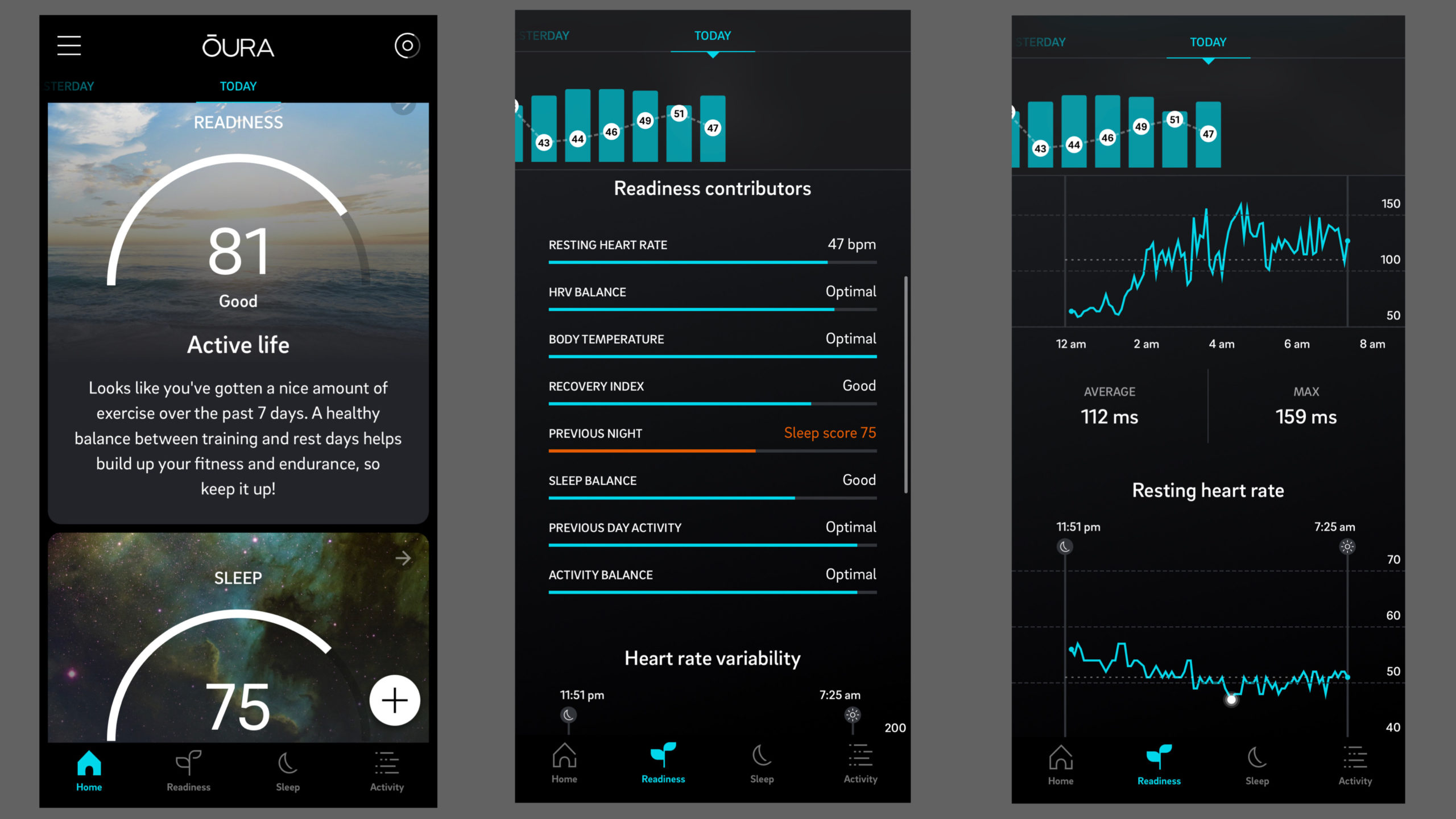-
chevron_right
Why… #10
comics.movim.eu / RandoWis · Wednesday, 6 July, 2022 - 05:00
- label
-
chevron_right
Ghosts these days be like…
comics.movim.eu / CatsCafe · Monday, 25 October, 2021 - 14:00
-
chevron_right
Which drink do you need today?
comics.movim.eu / CatsCafe · Thursday, 15 July, 2021 - 14:01
-
Th
chevron_right
For children, it’s not just about getting enough sleep. Bedtime matters, too
pubsub.do.nohost.me / TheNewDaily · Monday, 8 March, 2021 - 11:00 · 3 minutes
-
chevron_right
How to Stop Waking Up to Pee
pubsub.dcentralisedmedia.com / LifehackerAustralia · Wednesday, 10 February, 2021 - 21:45 · 3 minutes
-
chevron_right
Ecosa’s High-Tech Mattress Is Currently $250 off if You’re Prioritising Sleep in 2021
pubsub.dcentralisedmedia.com / LifehackerAustralia · Tuesday, 9 February, 2021 - 02:05 · 1 minute
-
chevron_right
What It’s Like to Track Your Recovery With the WHOOP Strap
pubsub.dcentralisedmedia.com / LifehackerAustralia · Friday, 5 February, 2021 - 22:00 · 8 minutes
- Would you be more annoyed by wearing a ring all the time, or a wristband? If you have a strong preference, this is honestly the biggest factor.
- Would you rather pay up front, or monthly? Oura is $US300 ($392) (or more) for the device, but after that, it’s free to use the app. The WHOOP strap is free, but a membership runs $US30 ($39)/month for a six months — though it’s a bit less if you sign up for a longer membership.
-
chevron_right
Things you can control in life…
comics.movim.eu / CatsCafe · Wednesday, 13 January, 2021 - 15:00
-
Th
chevron_right
Why I Tape My Mouth Shut at Night
Brett & Kate McKay · tests.marevalo.net / The Art of Manliness · Wednesday, 16 September, 2020 - 19:23 · 9 minutes
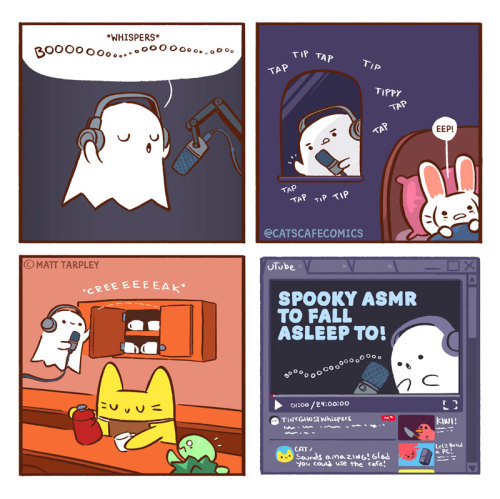
Ghosts these days be like…
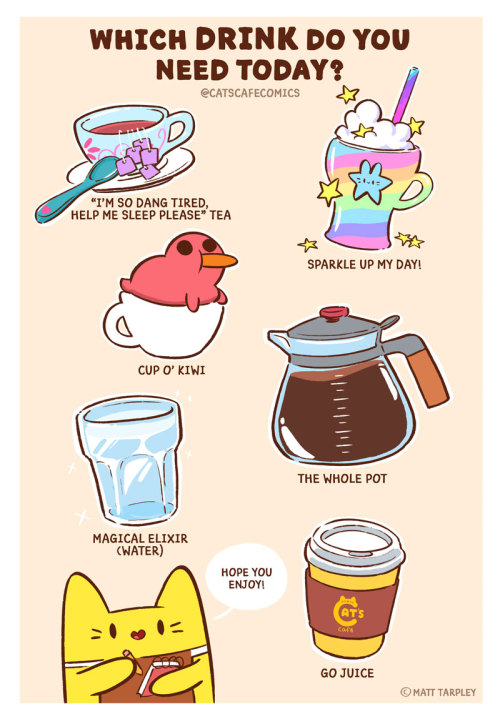
Which drink do you need today?

Adequate sleep is key to good health, wellbeing and proper functioning across all life stages, but is especially critical for children.
Poor sleep can inhibit rapid growth and development in early childhood.
And it’s not just about sleep duration; the time one goes to bed also plays an important role in the physical, emotional, and cognitive development of children.
A consistent early bedtime is especially important for young children transitioning from biphasic sleep (where children still nap during the day) to monophasic sleep (where sleep happens at night).
Late sleepers don’t always get the recommended amount of sleep, but evidence also suggests late bedtime is associated with sleep quality problems and difficulty falling asleep.
All this can add up to concentration, memory, and behaviour issues in children.
An early bedtime is good for physical health, too
One study of low-income, preschool-aged children found not getting enough sleep was associated with a higher risk of obesity.
A review of academic literature on the question found poor sleep is increasingly common in children, and associations between short sleep duration in early childhood and obesity are consistently found.
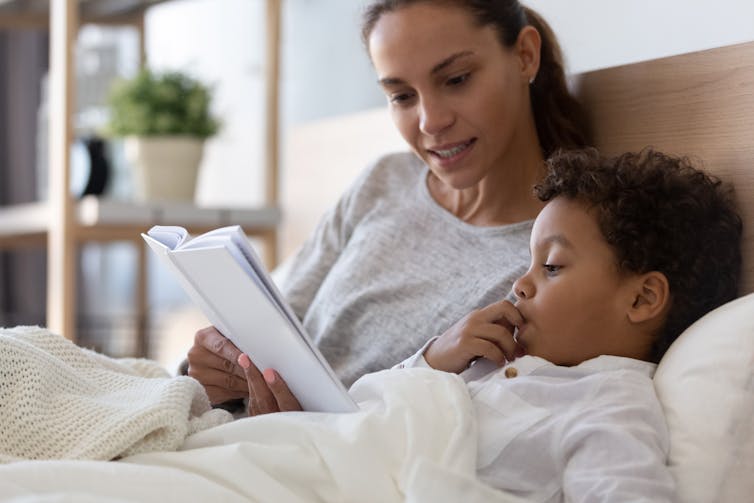 Adequate sleep is key to good health.
It’s worth noting that most of the studies on this question are cross-sectional, which means they look at data from a population at one specific point in time.
Adequate sleep is key to good health.
It’s worth noting that most of the studies on this question are cross-sectional, which means they look at data from a population at one specific point in time.
That has major limitations that make it hard to say poor sleep habits cause the higher obesity risk.
To know more, we need more longitudinal studies that examine change over time.
That said, emerging evidence from longitudinal studies supports the idea an early bedtime may be worth the battle.
One longitudinal study found: “Preschool-aged children with early weekday bedtimes were half as likely as children with late bedtimes to be obese as adolescents. Bedtimes are a modifiable routine that may help to prevent obesity.”
My own research , published last year with colleagues in the journal Acta Paediatrica , analysed four years of data from 1250 Aboriginal and Torres Strait Islander children aged five to eight years old.
The results highlight that even after controlling sociodemographic and lifestyle factors, children who had consistently late bedtimes (after 9.30pm) were on average 1.5 kilograms to 2.5 kilograms heavier at follow up three years later than children who go to bed early (about 7pm).
Nobody can yet say for sure what the exact relationship is between bedtime and obesity risk.
Maybe it’s that staying up late provides more opportunities for eating junk food or drinking caffeinated drinks.
Or there could be more complex physiological factors.
The body’s internal clock, which regulates sleep, also plays a crucial role in hormone secretion, glucose metabolism and energy balance.
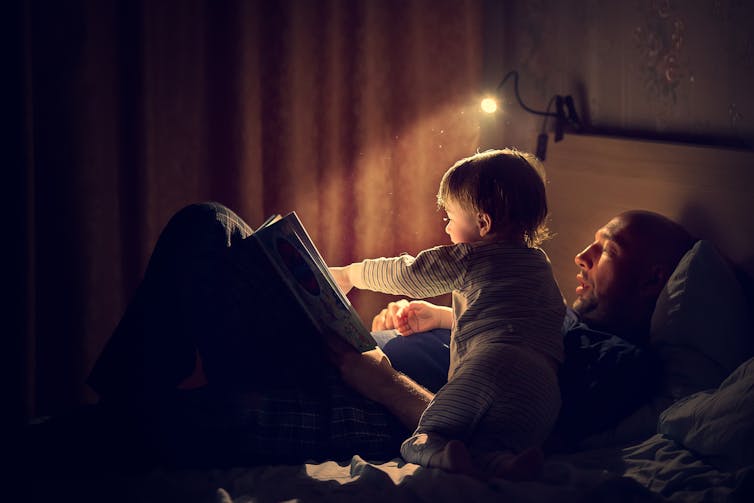 Try to stick to the same bedtime.
Try to stick to the same bedtime.
How late is late?
Sleep habits are shaped by a range of biological and cultural factors.
When parents set their child’s bedtime, they’re influenced by cultural norms, lifestyle and what they know about the importance of sleep.
There are clear guidelines for sleep duration for each age group, but the time a child should go to bed isn’t always as clearly defined.
For a preschooler , I’d recommend a consistent bedtime between 7pm and 8pm to ensure adequate sleep (recognising, of course, that work and caring responsibilities can make this really difficult for some parents).
Develop an early bedtime routine for your child and try to stick to it, even when it’s “not a school night”.
Irregular bedtimes disrupt natural body rhythms and, as many parents know from direct experience, can lead to behavioural challenges in children.
Early childhood is a critical time in which the foundations of life-long habits are built.
Developing healthy sleep habits can set children on the right path for better future health and wellbeing.
________________________________________________________
![]()
Yaqoot Fatima , Senior Research Fellow, James Cook University
This article is republished from The Conversation under a Creative Commons licence. Read the original article .
The post For children, it’s not just about getting enough sleep. Bedtime matters, too appeared first on The New Daily .
We’ve all been there: a groggy, middle-of-the-night realisation that, ugh, it’s time to pee again . While sometimes this is the result of a medical condition, often it’s just an inconvenient routine. In that case, there are a few simple fixes that can make nighttime bathroom breaks a lot less common.
But first, that caveat about medical issues. Definitely see a healthcare professional if you’re concerned about your sleep or your bladder. Sometimes, waking to pee (“nocturia,” they call it) happens because you’re peeing too much all the time. This can have a variety of causes, from common ones like a urinary tract infection to some serious ones like diabetes or heart failure.
On the flip side, you may be waking up because of other issues that are impacting your sleep, and then once you’re awake your brain says, welp, might as well use this time to take a trip to the bathroom. In those cases, the peeing isn’t the issue, so please seek medical help if something seems wrong. Otherwise, these tips might help:
Hydrate earlier in the day
Often we aren’t too thirsty in the morning, and maybe we’re too busy during the day to drink very much. If you find yourself drinking most of your fluids in the evening, that’s setting you up to go to bed with a full bladder. The fix here is easy: drink water earlier in the day, so you don’t find yourself filling up right before bed.
(If you chase a hydration target during the day — aiming for eight glasses, say — reconsider whether that amount of water is actually helping you. Many of us don’t need as much extra water as we think , so experiment with reducing that number to see if it helps.)
Notice we’re just changing the timing of how much we drink, not cutting water off and dehydrating ourselves. Being dehydrated can also make it hard to get comfortable at night, the Sleep Foundation notes , due to distractions like dry mouth or headaches.
Don’t drink right before bed
If you’ve hydrated throughout the day, it should be no problem to stop drinking liquids an hour or two before bed. This includes caffeine, for obvious reasons: you don’t want it to keep you awake. While caffeine is infamous for its diuretic effect (making you pee), if you’re habituated to it, the effect is pretty minimal .
And you shouldn’t have alcohol before bed if you can help it. Alcohol is definitely a diuretic, and it’s also known to disrupt sleep .
Elevate your legs
The Sleep foundation also suggests you try elevating your legs for a few hours before bed, because your body can reabsorb some of the water from your legs when you’re lying down. This can just mean sitting on the couch with your legs up; you don’t have to do a headstand. Work some quality lounging into your bedtime routine.
How To Transform Your Bright And Noisy Bedroom Into A Sleep Paradise
Good sleep really matters, but even if you have what it takes to get a good night’s rest you still have to combat the world around you. You can’t control the sun or the noise outside, but you can do a few things to make your bedroom dark and quiet...
Read moreMake it easy to get back to sleep
Occasional bathroom trips will still happen despite our best efforts. Sometimes the problem isn’t that you had to get up, but rather that it’s hard to get back to sleep afterward.
So, do your best to make your bedroom an easy place to sleep . Use blackout curtains to keep your bedroom dark, or use a sleep mask, which is just a blackout curtain for your eyeballs. Earplugs or a white noise machine can help if noise tends to bother you. And whatever you do, do not check your phone just because you’re awake.
Consider adjusting the temperature of your house at night, since most of us find it easier to sleep in slightly cooler temperatures. Set up a nightlight or keep a small, dim flashlight by your bed so you don’t have to turn on any lights. (There are even toilet seats with a built-in nightlight for exactly this reason.)
The post How to Stop Waking Up to Pee appeared first on Lifehacker Australia .
The average person will spend about 26 years of their life sleeping. Given that insane statistic, it makes sense that we’d want to be as comfortable as possible, right? Luckily for us, beloved bedding brand Ecosa has just announced a $250 discount on their mattress and bed bases and 20% off on everything else. They’re also offering free express shipping on smaller items as well.
The sale is running from today (1st February) until the 14th February, which is just in time for Valentine’s Day. If you’re not sure what to gift your SO this year and you both enjoy spending time in the bedroom – nabbing some new bedding is a surefire winner. All you have to do is enter the code VDAY21 at checkout and you’re good to go.
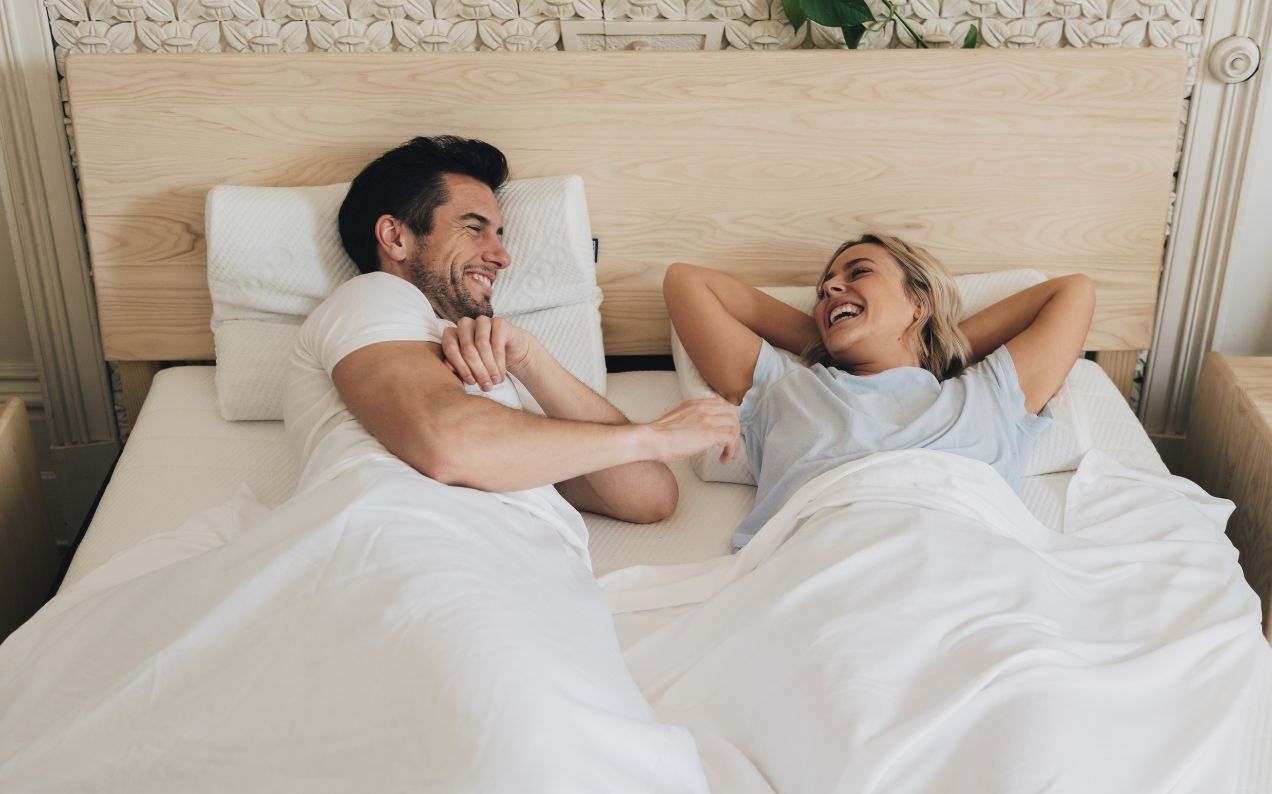
Ecosa’s queen mattress is currently on sale for $849 (down from $1,099) and their king mattress is sitting at $949 (down from $1,199).
Nabbing a new mattress for under $1000 is worth shouting from the rooftops, especially when it comes with all the bells and whistles like adjustable firmness and back support. Each mattress is also fitted with pincore holes (to keep you cool) and zero-disturbance technology (which means you won’t feel your partner moving). Sound good? We thought so.
 Image: Instagram @ecosa_sleep
Image: Instagram @ecosa_sleep
Why stop there though? Ecosa is also home to timber bed bases and bedside table if you’re keen to go all out and redesign your entire bedroom. When the prices are this good, it’d be rude not to.
They don’t call them the sleep experts for nothing. Ecosa really knows what they’re doing when it comes to getting a great night’s snooze. Sweet dreams!
Shop Ecosa’s entire bedding range here .

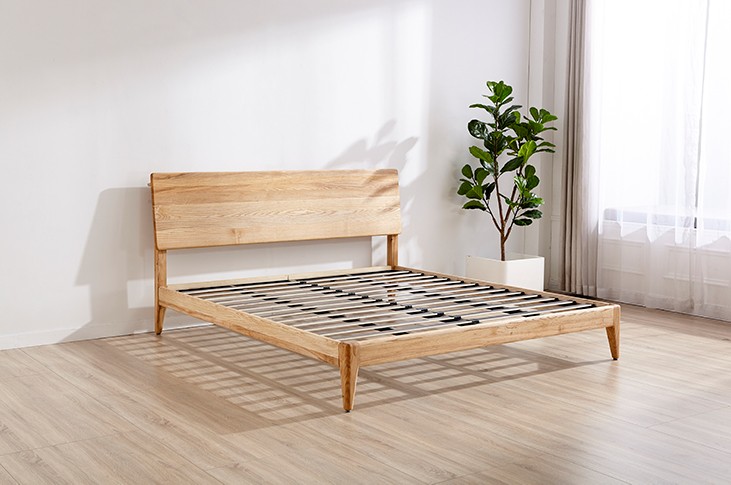
Bed Base in Queen Size, $1,149
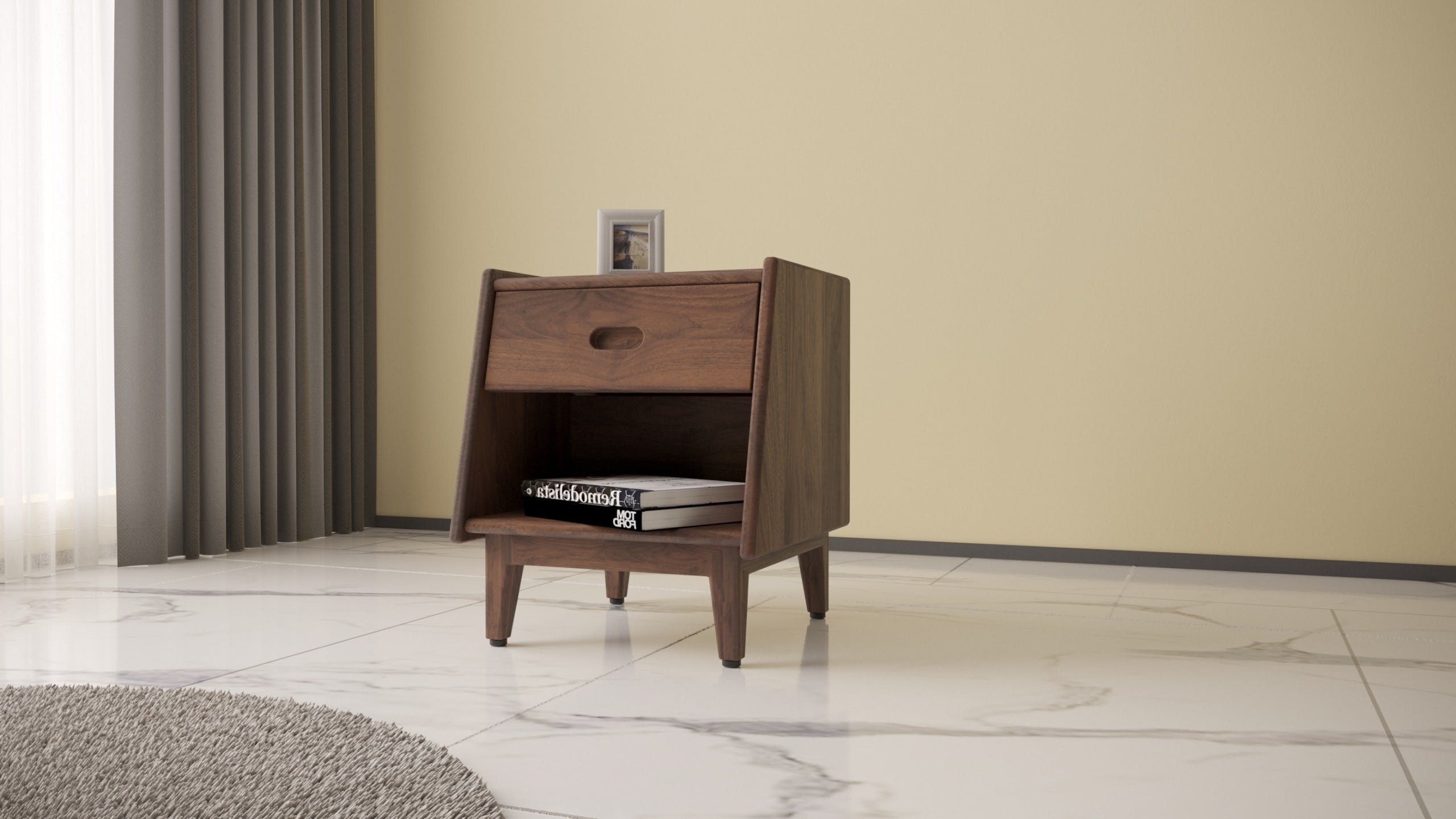
The post Ecosa’s High-Tech Mattress Is Currently $250 off if You’re Prioritising Sleep in 2021 appeared first on Lifehacker Australia .
In the final instalment of the sleep tracking fitness challenge, I’m going to talk about my experience with the WHOOP strap. This and the Oura ring, which I covered last week , are the two big players in the recovery tracking space. Both keep tabs on your activity during the day and your heart rate at night, and aim to tell you whether you’re getting enough good quality sleep to support your athletic endeavours.
Both WHOOP and Oura more or less do what they promise. Neither is necessary to track your sleep ; low-tech solutions can do the job well enough. But if you’d like more data, either is a good device for the purpose. Both will monitor your sleep and give you a score; both will relate that score to how much exercise you’ve been getting. WHOOP may work better for you if you’re an endurance athlete or do a lot of cardio, while Oura is probably the better pick if you mainly do other types of exercise or are interested in sleep more generally. I preferred Oura’s day-to-day experience, but WHOOP’s monthly analyses are a data nerd’s delight.
What It’s Like to Track Your Recovery With the Oura Ring
In our last instalment, I started experimenting with sleep tracking in hopes of recovering better for my weightlifting sessions. I’ve used the Oura ring and Whoop band, but today I’ll talk mainly about Oura — my favourite of the two — and about what metrics I found useful.
Read moreThose thoughts amount to my best guide to choosing between the apps, but there are also two important questions you need to ask yourself before buying one or the other:
The WHOOP’s pricing model makes me wonder: How long do you need to track your recovery? I came across several discussions on the r/whoop subreddit in which people said they only used the device for six months or a year. By the end of that time it had effectively taught them how to prioritise their sleep and balance their activity and recovery.
I didn’t have to ask myself this question, because the WHOOP folks gave me access to the app to test it out, but I find it somewhat disconcerting to ponder the existential question: H ow long I will care?
Anyway, WHOOP has some cool features.
What it’s like to wear the WHOOP strap
The WHOOP strap is a gadget that looks like a watch, except it has no screen. It’s a lightweight rectangle with an elastic strap. There are green LEDs on the skin side of the rectangle that pick up your pulse, and an accelerometer to detect motion.
The strap is meant to be worn 24/7, and it has a clever way to charge. There’s a little plastic brick that you charge separately, and then when the strap’s battery runs low, you unplug the brick from its cord and slip it onto your wristband. This way, you never have to take off the strap itself.
That said, if you get the band wet — say, if you wear it in the shower — you’re then stuck wearing a wet band. WHOOP sent me a spare one, which was handy to change into on those occasions. (Spare bands, and spare charging batteries, both cost extra.)
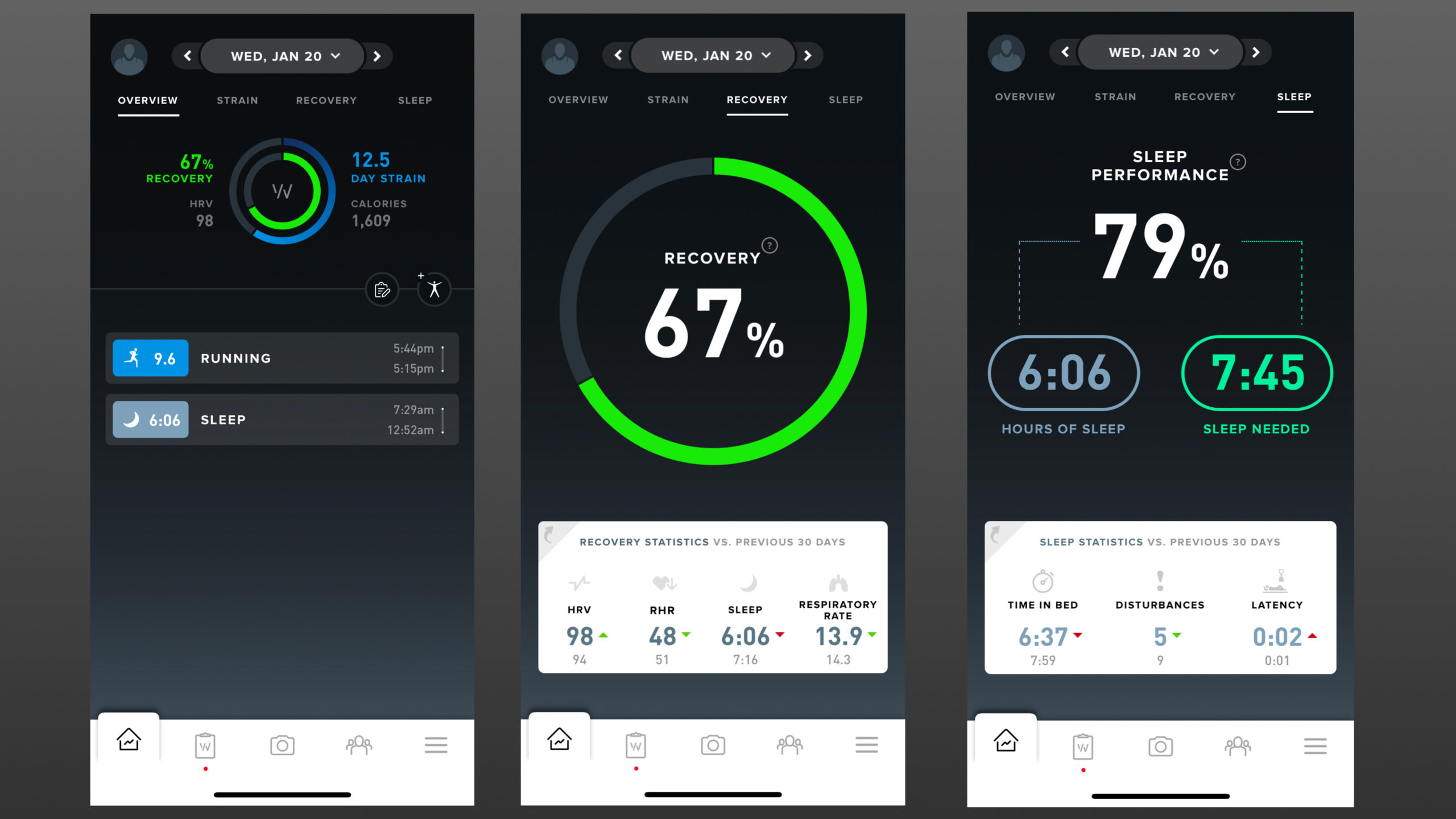
Using the app
WHOOP’s app is straightforward in some places and arcane in others. At first, I was always forgetting where I saw a certain number or feature. But once you get the hang of it, you’ll find that the app is full minutely detailed views and extra information.
Right up front, where you can’t miss it, are two numbers: your strain score for the day, and a recovery score based on how you slept.
The strain score is based on your heart rate throughout the day. This makes the most sense for people who do a lot of cardio, which made the app slightly awkward to use as a person who only really walks and lifts weights. If I were a runner or if I played team sports or did a lot of aerobics videos, I’d love this.
Your strain gets higher as you do more exercise, and the number is calculated in a way that isn’t particularly easy to wrap your head around. Still, bigger numbers mean you’ve spent more time with your heart rate elevated. That means that if you spent a lot of time with a high heart rate because you were nervous, rather than exercising, your strain will be high — which makes sense, honestly, because it still represents stress on your body.
Recovery is another single number, this time given as a percentage. If you are less than 33% recovered, you’re in the red; if you’re over 66%, you get green. If you’re working hard but also sleeping well, you’ll see a lot of yellows and greens, maybe the occasional red. A string of reds, on the other hand, probably means something is wrong.
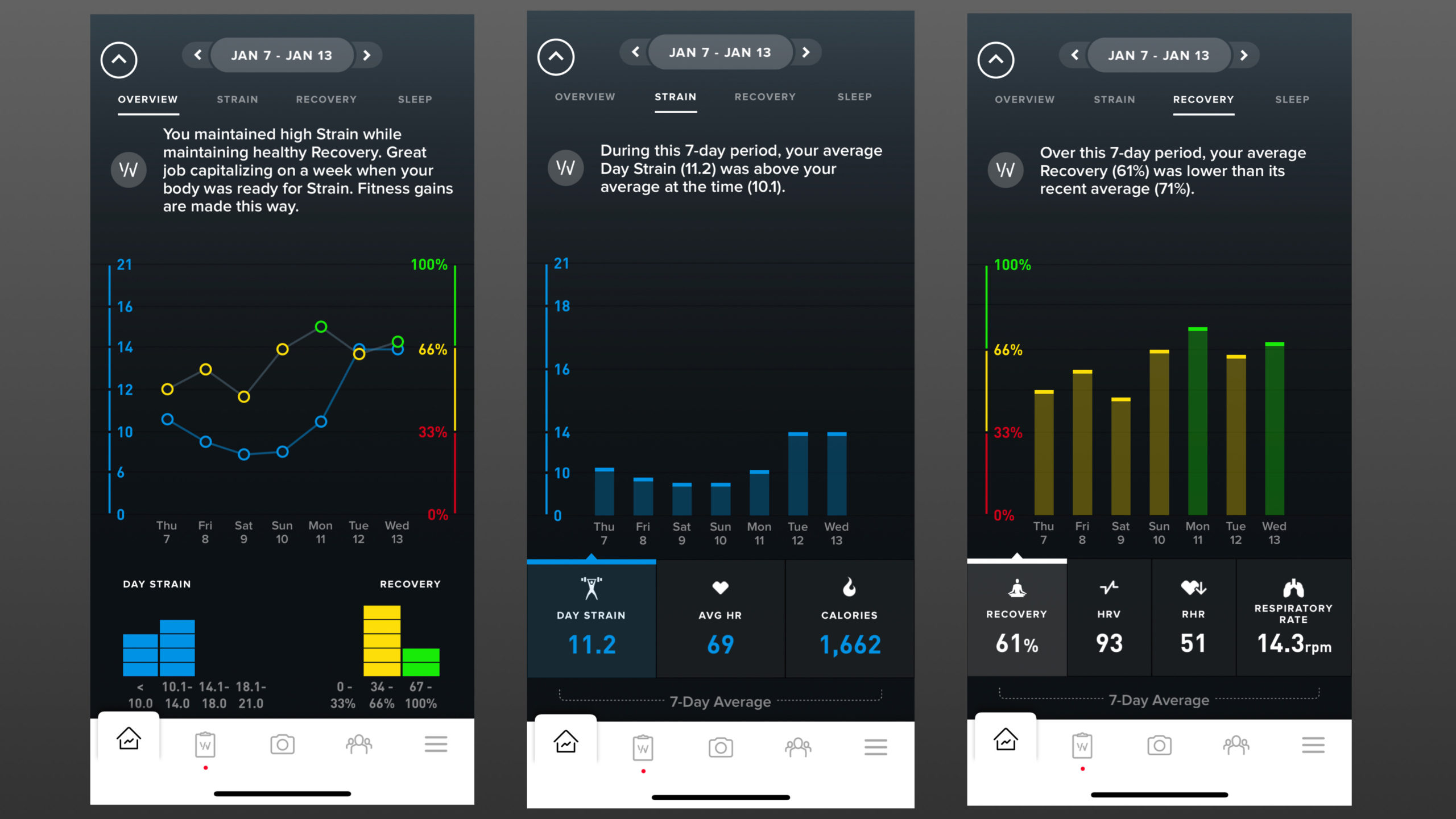
As you’re looking through the app, my best advice is to mess with everything you see. If there’s a little card giving you some information, tap it; it might flip over and give you more details. When you’re looking at your recovery score, swipe up and a chart of your past week’s scores will suddenly slide into view.
The coolest surprise feature, which I didn’t notice until someone from the company pointed it out to me, is that if you turn your phone sideways you can see a screen showing your heart rate throughout the day, with sleep and exercise highlighted.
One of the most fascinating features WHOOP offers is the sleep coach. You tell it what time you’d like to wake up tomorrow, and it tells you when you should get to bed tonight. That’s not so special in itself; many apps do the same. What’s different here is that you can choose whether you want to “peak” versus “perform” versus “get by.” I don’t know how accurate the three estimates truly are, but on a gut level they felt about right. For example, on a day that my sleep need was calculated at 7:48, the recommended sleep time for peak performance was 8:33; to simply get by, it was 5:59.
You can learn a lot from the weekly and monthly reports
I found the daily screens a little confusing to navigate, but I loved the weekly and monthly reports. You don’t get the monthlies until you’ve been wearing the strap for a full calendar month, but they’re worth the wait.
These reports tell you about your trends. Since the whole point of comparing recovery to strain is to figure out whether they balance out, there are charts to show how well you aligned the two.
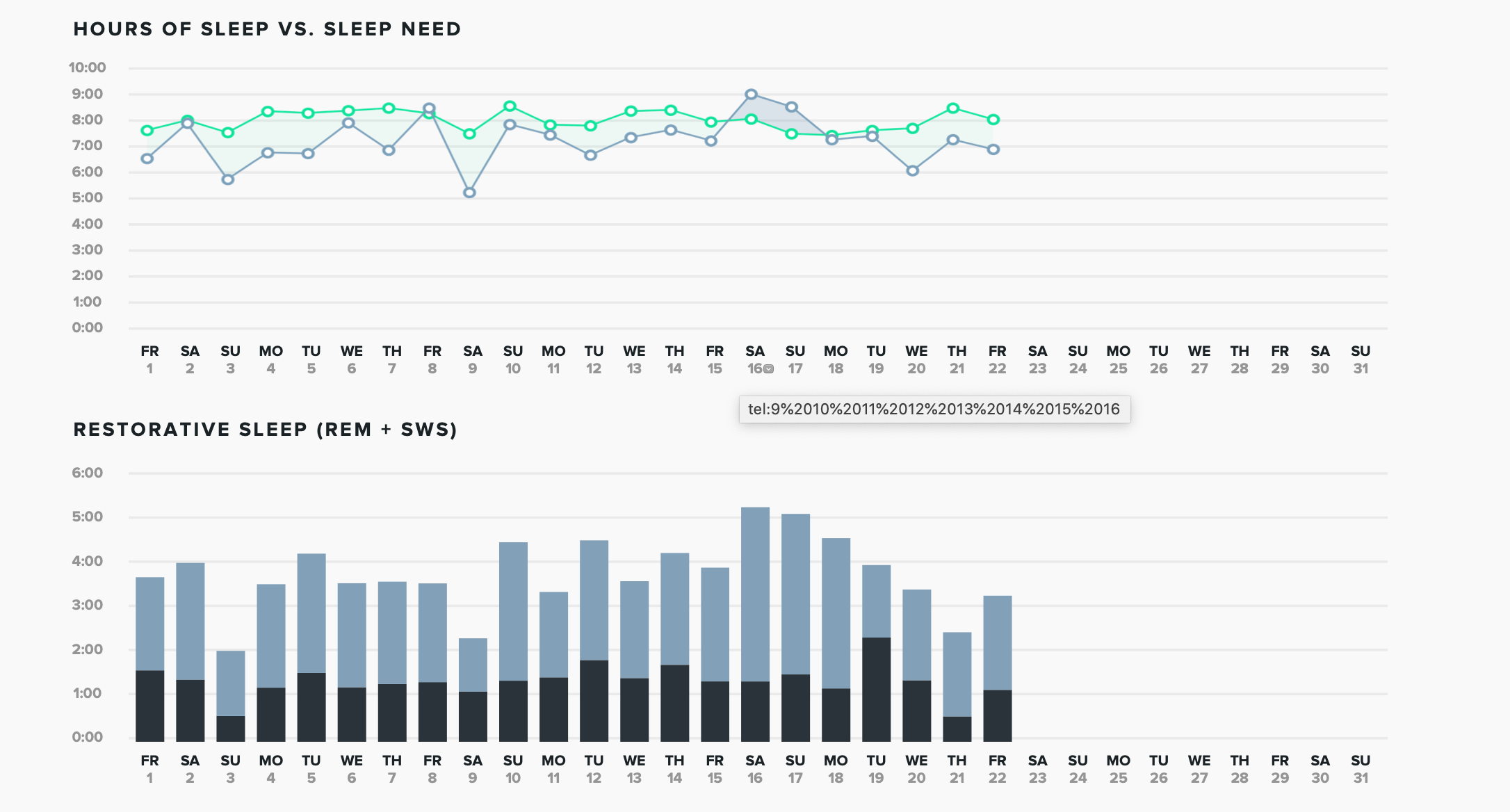
I mean, just look at these:
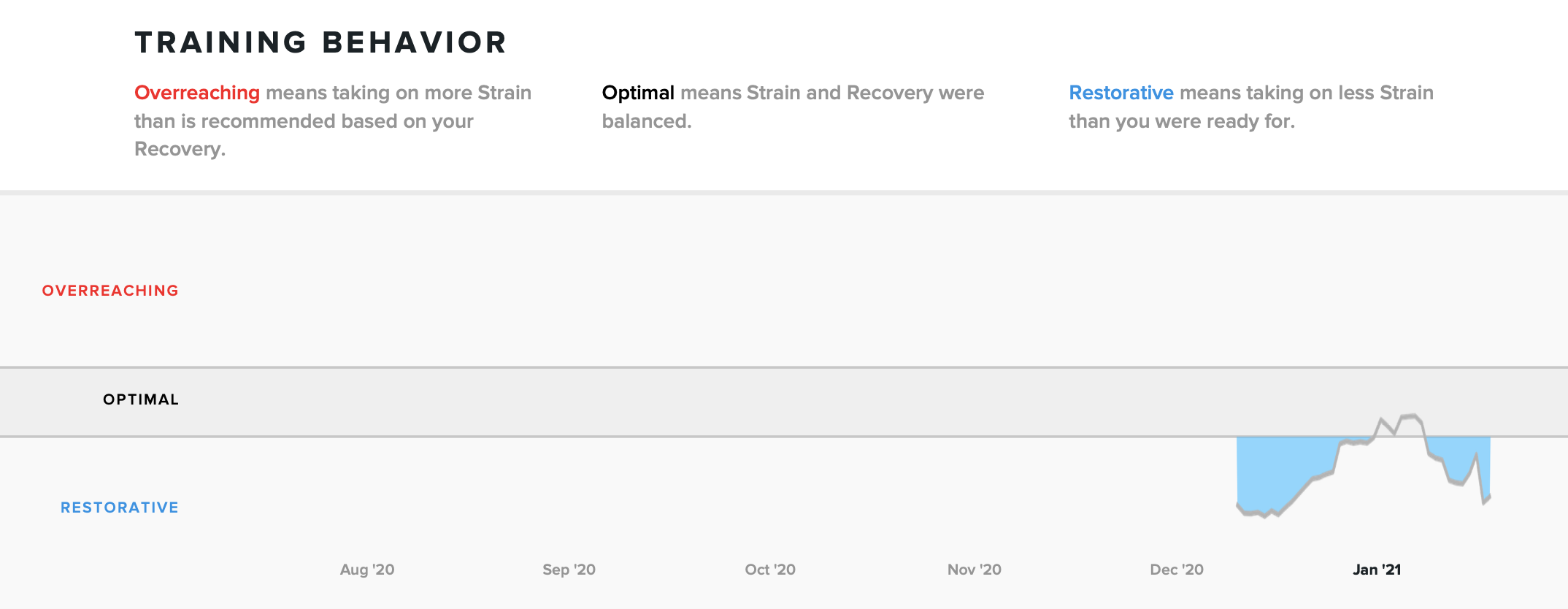
By far the coolest graph in the set, and probably the coolest feature, is the correlation matrix you get from the daily journal feature.
To use the journal, you need to open the app each day (or find the clipboard icon on a past day’s screen) and answer a little survey that you’ve set up for yourself. Basically, you’re choosing variables to look at, and the monthly report will tell you whether those variables correlate with good sleep or poor sleep. I chose several, including whether I had had alcohol and whether my stress was particularly high. You can use the journal to evaluate supplements you’re taking, to see if your hydration levels affect your sleep, or to see if your recovery score changes when you’re on your period. The only catch is that the app needs a mix of yeses and nos (five of each, minimum) to be able to calculate correlations. Anyhow, here’s one of mine, for alcohol:

I think every sleep expert I’ve ever interviewed has mentioned that people rarely believe alcohol affects their sleep , and are astounded when they start paying attention and find out that it does. It’s interesting to see the data right in front of me.
Now, these are correlations , distinct from causation. I know that I tend to stay up late on nights I have alcohol, and that these nights tend to be at the end of a training week, when I’m already more likely to be under-recovered. If you meditate or take a supplement on nights you expect to have difficulty sleeping, that thing could show up with a negative correlation even if it really does help you sleep. So it’s important to be thoughtful about how you interpret your data.
All that said, the standard caveats apply: I wouldn’t rely on any consumer sleep tracking device to tell me for sure whether I’m getting enough of a given sleep stage (remember, Oura tells me I always get too little REM sleep , and WHOOP routinely tells me my REM is on the high side). I use the data from sleep trackers to help guide my medium and long term planning, rather than as a prompt to skip workouts. Still, I think both devices work well to help you see those patterns, each in its own way.
The post What It’s Like to Track Your Recovery With the WHOOP Strap appeared first on Lifehacker Australia .
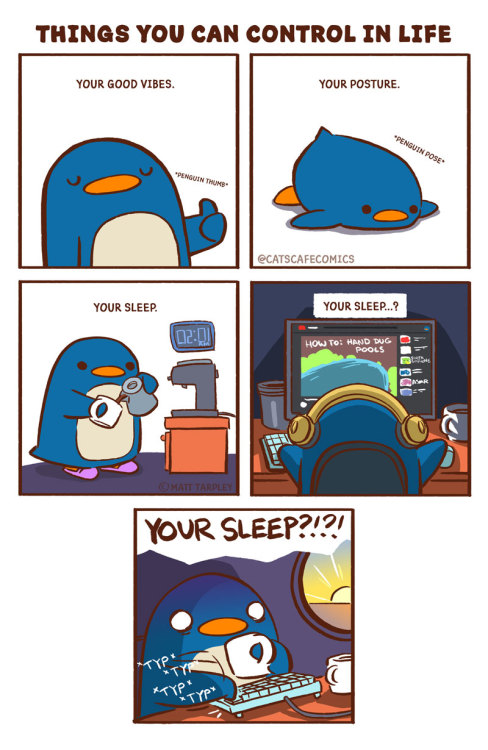
Things you can control in life…
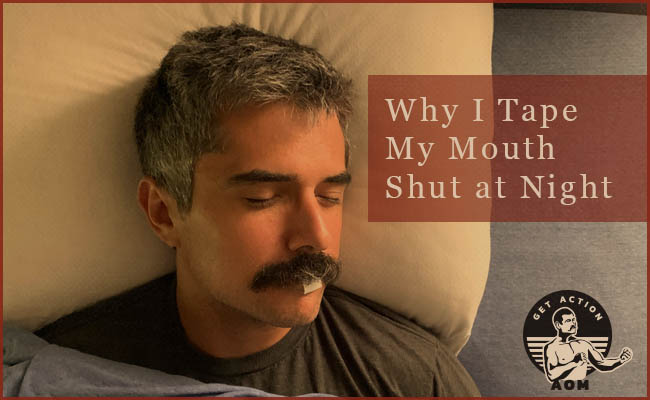
My bedtime routine for the past month or so has looked like this:
Take out contacts.
Brush and floss teeth.
Say prayers.
Read a book.
Tape mouth shut.
*Record scratch*
“Tape your mouth shut? Really, Brett? You weirdo.”
Yes, it is weird, but there’s a method to my weirdness.
I got the idea from reading Breath: The New Science of a Lost Art , in preparation for interviewing its author, James Nestor, for the podcast . In the book and in our interview, Nestor shares research on how breathing out of your mouth is bad for you, especially while you’re sleeping. He then shares an easy tip on how you can fix your chronic mouth breathing at night: taping your kisser shut.
Here’s why it works, and why, the initial weirdness factor aside, you might consider trying it yourself.
The Downsides of Nighttime Mouth Breathing
When Nestor dug into the research on breathing, he found that for thousands of years, and in diverse cultures around the world, the nose had been favored over the mouth as the primary pathway for inhalation. Air breathed through the former is richer in oxygen, and gets moistened and filtered in the nasal passages. Breathing through the mouth, on the other hand, lacks these benefits, and when engaged in excessively at night, can create the following problems:
Snoring. Inhaling air through your mouth vibrates the soft tissue in the back of your throat more than inhaling air through your nose does, and this vibration can result in snoring. What’s more, when you breathe through your open mouth, your tongue falls back into your throat, narrowing your airway. With your airway constricted, the air you breathe in is even more likely to generate snore-inducing reverberations in the tissue of the throat.
Snoring doesn’t just annoy your spouse; it can also be a sign of a more serious sleep issue, specifically . . .
Sleep apnea. Sleep apnea is a disorder in which your breathing is disrupted while you sleep. You experience periods in which your breathing pauses or becomes very shallow more often than is usual, and these cessations in breathing make your sleep less restful and restorative, leading to myriad health problems, including fatigue, high blood pressure, stress, depression, and headaches.
Mouth breathing at night is a significant contributor to sleep apnea. As discussed above, when you breathe through your mouth while you slumber, the airway in your throat constricts, causing snoring. When the soft tissue in the back of your throat collapses completely, your airway is obstructed, and you experience sleep apnea.
Nestor experienced this firsthand during an experiment he ran on himself in which he had his nose entirely plugged up by a doctor, and could only breathe through his mouth for 10 days. Having previously been only an occasional snorer, he began to snore for four hours each night and even started developing obstructive sleep apnea. Tests showed his body was under greater stress throughout his waking hours, and his blood pressure shot up 13 points, putting him in stage one hypertension. He also felt especially fatigued during the day.
Bad breath . If, upon waking, your breath smells like you ate a dirty diaper, it’s probably because you slept with your mouth open all night. Saliva is nature’s mouthwash. It has antibacterial agents in it that kill odor-causing bacteria. When you sleep with your mouth open, that bad-breath-destroying saliva dries up, resulting in stinky morning breath when you rise.
Periodontal disease. Keeping your gums healthy is largely a matter of keeping up a regular routine of brushing and flossing (not that the latter is always easy to do; here’s how I finally made flossing a habit myself ). But stopping nighttime mouth breathing can also improve gum health. Saliva helps kill the bacteria in our mouths that cause gingivitis. And again, when you breathe with your mouth open at night, that saliva dries up, and those little bacteria can proliferate and fester, causing your gums to get inflamed.
Why We Mouth Breathe at Night
If mouth breathing at night is so bad for us, then why do we do it? There are several factors behind this common proclivity towards oral inhalation:
Nasal congestion. Many folks breathe through their mouths when their noses are stuffed up due to having allergies or a cold. But here’s the kicker: breathing through your mouth can actually increase nasal congestion, which makes you breathe through your mouth even more. It’s a vicious cycle!
“When the nasal cavity gets congested, airflow decreases and bacteria flourish,” Nestor notes in Breath . “These bacteria replicate and can lead to infections and colds and more congestion. Congestion begets congestion, which gives us no other option but to habitually breathe from the mouth.”
When Nestor had his nose plugged up for 10 days straight, turning him into a strict mouth breather, his sniffer got progressively more stuffed up as the bacteria in his sinuses increased. When the doctor running the experiment pulled the plugs out at the end, he ran an endoscope up Nestor’s nostrils and saw a soupy mess of congestion.
So how do you break the vicious cycle of mouth-breathing-induced nasal congestion so you can breathe through your nose again? Dr. Jayakar V. Nayak — the doctor who plugged Nestor’s nostrils — recommends starting off with a saline nasal spray and a low-dose steroid spray (like Rhinocort) to help open things up. Both can be bought over-the-counter at drug stores.
Once you get your nose decongested, you can start breathing through it again while you sleep.
Deviated septum. Another reason people breathe through their mouth while they sleep is that they have a deviated septum. A deviated septum occurs when the thin wall between your nasal passages has shifted off-center, making one nasal passage smaller than the other and reducing airflow. Congestion is more likely to occur in folks with this condition. Decongestants can help clear things up. Nasal reconstruction is usually needed to fix severely deviated septums.
Habit. If you aren’t congested and don’t have a deviated septum, but you still breathe through your mouth while sleeping, the reason is probably a learned propensity. Maybe you had a bout of bad congestion as a kid that caused you to sleep with your mouth open for weeks or months, resulting in you picking up the habit.
I know I’m in this group. As a kid, I’d get sinus infections every fall and winter, and for five months out of the year, I’d have a stuffed up nose that forced me to breathe through my mouth at night. Here I am thirty years later, and I still breathe mostly through my mouth when I sleep.
While I haven’t experienced sleep apnea, I do snore occasionally, wake up every morning with a dry mouth and bad breath, and get tsk-tsks from the dental hygienist about my gum inflammation.
So if you keep your mouth open at night while you sleep, how do you break the habit when you’re unconscious and dead to the world?
How a Little Piece of Tape Can Stop Nighttime Mouth Breathing
Easy. It keeps your mouth shut.
The idea is that the tape trains your lips to stay closed so that you primarily breathe through your nose. Eventually, nasal breathing will become habitual, and you won’t need the tape.
Training the mouth to stay shut at night isn’t a new idea. In Breath , Nestor notes that there are accounts of some Native American tribes in which mothers would gently shut their babies’ lips while they slept to train them to breathe through their noses. A 19th century doctor named George Catalin recommended tying a bandage around your jaw at night like the ghost of Jacob Marley to achieve the same effect.
In recent years, special “sleep tape” has been developed that you can attach to your mouth in elaborate ways. But breathing experts recommended a method to Nestor that’s simpler and dirt cheap.
Just buy some hypoallergenic micropore tape from your local drugstore. A roll will only set you back a buck. Before you go to sleep, tear a small square — all you need is a little strip about the size of a postage stamp — and place it right in the center of your closed lips. Putting it here keeps your mouth together and keeps some space on the sides of your mouth open if you feel like you need to breathe through your mouth or cough at night.
I started taping my mouth shut at night about a month ago and have been pleasantly surprised by the results. The first night it felt a bit awkward, to be sure. I remember waking up disjointed in the middle of the night trying to figure out why I couldn’t open my mouth. In my half-awake state I thought I had excreted some sort of goop that had dried up and sealed my lips shut, so I wiped my mouth really hard, taking the tape off in the process. The next night I made it all the way ‘til morning with the tape still on.
Kate hasn’t reported snoring from me, and my mouth feels less dry and doesn’t smell as bad. I’ve also noticed a lessening in my usual allergy-induced sinus congestion. I’ve had a few nights where I’ve been stuffed up going to bed, and in putting the tape on my mouth, I initially had to battle feeling like I was suffocating for a few minutes (having that space open on the sides of the tape gave me some air). But surprisingly, once the tape was on for awhile, my nasal passages started to clear up, and I could breathe just through my nose.
Overall, I’m happy with how this odd experiment has worked out for me. Has breathing through my nose while sleeping been a complete game-changer in my life? Not really, but because it’s such an easy thing to do and has a decent amount of upside, I think it’s worth it. The only downside is that it inhibits pillow talk with Kate; I can only make mumbling, grunting noises once I tape up and bed down.
If you don’t plan on trying to break the mouth breathing habit at night, at least try to focus on breathing through your nose during the day — when you can consciously control it. In my podcast interview with Nestor, he argued that shifting from mouth breathing to nasal breathing is the single biggest thing people can do to improve their breathing, and with it, their overall health.
Listen to my interview with Nestor for more interesting insights about breathing:
The post Why I Tape My Mouth Shut at Night appeared first on The Art of Manliness .



